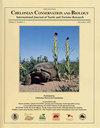Assessing Head Morphology Dimorphism in the Midland Painted Turtle (Chrysemys picta marginata) Using a Photographic Questionnaire
IF 0.8
4区 生物学
Q3 ZOOLOGY
引用次数: 4
Abstract
Abstract The ability to identify the sex of animals accurately is important in population studies. Emydid turtles (Testudines: Emydidae) demonstrate a number of sexually dimorphic characters, including head (cranial) size and structure. Field observations from a long-term study of midland painted turtles (Chrysemys picta marginata) in Algonquin Provincial Park, Ontario, Canada, suggested distinct differences in external head morphology between the sexes. We evaluated these putative sexual differences in C. picta head morphology by conducting a visual questionnaire involving human observers of varying levels of experience (novice, beginner, intermediate, and advanced). Observers were capable of distinguishing the sexes based solely on head morphology with a high degree of accuracy (between 79% and 86% success) across experience levels. Observers identified head shape as a defining character distinguishing the sexes. We suggest that visual questionnaires are a quantifiable method of assessing dimorphic characters that can be used in addition to traditional morphometrics or geometric morphometrics to demonstrate a visual, rather than simply statistical, difference among characters and sexes. Despite the breadth of research conducted on C. picta, our study is among the first to describe, assess, and discuss the functional significance of head dimorphism in this model species.用摄影问卷评估米德兰彩龟(Chrysemys picta marginata)头部形态二态性
准确识别动物性别的能力在种群研究中很重要。赤蠵龟(鳖科:赤蠵龟科)表现出许多两性二态特征,包括头部(颅骨)的大小和结构。在加拿大安大略省阿尔冈昆省立公园对米德兰彩绘龟(Chrysemys picta marginata)进行了长期的野外观察,发现两性在头部外部形态上存在明显差异。我们通过对不同经验水平(新手、初学者、中级和高级)的人类观察者进行视觉问卷调查,评估了这些推测的picta头部形态的性别差异。观察者能够仅根据头部形态区分性别,在经验水平上具有很高的准确性(成功率在79%到86%之间)。观察者认为头部形状是区分性别的决定性特征。我们建议,视觉问卷是一种可量化的评估二态特征的方法,除了传统的形态计量学或几何形态计量学之外,还可以用来展示视觉上的,而不是简单的统计上的,字符和性别之间的差异。尽管对C. picta进行了广泛的研究,但我们的研究是第一个描述、评估和讨论这种模式物种头部二态性的功能意义的研究之一。
本文章由计算机程序翻译,如有差异,请以英文原文为准。
求助全文
约1分钟内获得全文
求助全文
来源期刊
CiteScore
1.70
自引率
14.30%
发文量
17
审稿时长
>12 weeks
期刊介绍:
Chelonian Conservation and Biology is a biannual peer-reviewed journal of cosmopolitan and broad-based coverage of all aspects of conservation and biology of all chelonians, including freshwater turtles, marine turtles, and tortoises. Manuscripts may cover any aspects of turtle and tortoise research, with a preference for conservation or biology. Manuscripts dealing with conservation biology, systematic relationships, chelonian diversity, geographic distribution, natural history, ecology, reproduction, morphology and natural variation, population status, husbandry, community conservation initiatives, and human exploitation or conservation management issues are of special interest.

 求助内容:
求助内容: 应助结果提醒方式:
应助结果提醒方式:


